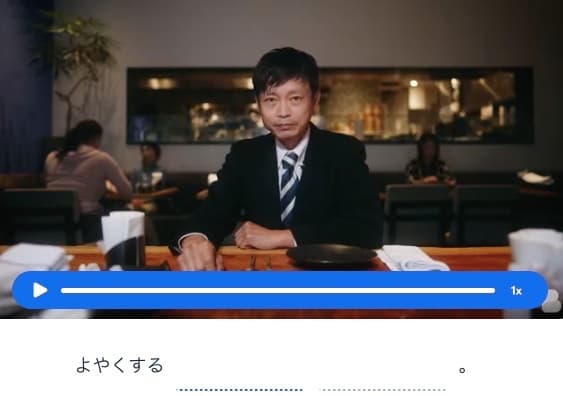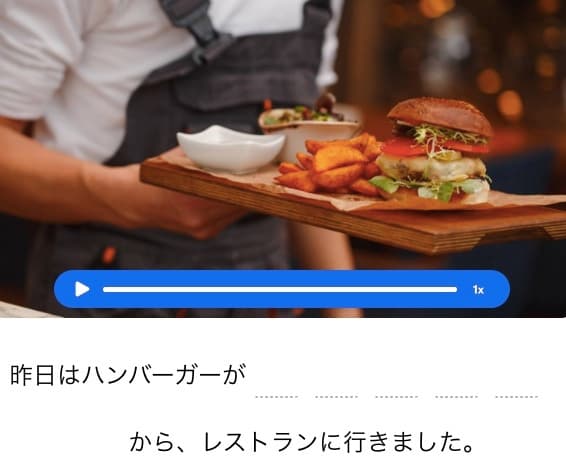I want to learn...
Author:

Ayako Sasso
Japanese cuisine is getting more and more popular worldwide, and knowing how to order food in Japanese is essential if you want to experience it at its source. Ordering food in Japanese is a great chance to practice your language skills. Although pointing to pictures on the menu may be a simpler way of ordering, it takes away an incredible opportunity for those of you learning Japanese, doesn’t it?
This guide will teach you everything you need to know to have a great experience at a Japanese restaurant. We’ll begin by describing the many types of restaurants in Japan, then talk about what to do when entering a restaurant, ordering your food, getting your bill and leaving the restaurant. By the end of this guide, you’ll be confident in your knowledge of the customs and language in Japanese restaurants.
Restaurants in Japan
First let’s look at the types of restaurants you can find in Japan and what they are called. Restaurants can be divided roughly into two types: ‘specialized’ and ‘general’ restaurants. Let’s look at a few examples:
Specialized restaurants
Many restaurants in Japan specialize in just one type of food. A few common examples are sushi restaurants or ramen restaurants. It is common knowledge in Japan that ramen is not an option in a sushi restaurant and vice versa, though in other countries Japanese restaurants offer a mix of all kinds of dishes in one place. Keep this in mind as you select a restaurant for your night out to ensure that you and those you are with can fully enjoy your meal!
Here are some examples of specialized restaurants:
Sushi restaurants (sushi-ya– 寿司屋)
A sushi-ya offers customers the option of sitting at either a regular table or at a counter (like a bar counter). Sitting at the counter gives you the opportunity to watch a sushi chef at work as they perform the art of making sushi. There is a wide price range for sushi restaurants based on their location.
Kaitenzushi restaurants (kaitenzushi– 回転寿司)
A kaitenzushi is an affordable sushi restaurant where plates of sushi are presented to customers on a conveyor belt. You are free to pick any plate you like as they pass by!
Soba restaurants (soba-ya– 蕎麦屋)
A soba-ya specializes in soba, which is a type of noodle made of buckwheat flour. Some soba restaurants may serve udon noodles as well.
Tempura restaurants (tempura-ya– 天ぷら屋)
At a tempura-ya, you can enjoy any type of crispy, deep-fried tempura dishes. If you are looking for the ultimate tempura experience, visiting a tempura-ya is a must.
Yakitori restaurants (yakitori-ya– 焼き鳥屋)
Yakitori literally means ‘grilled chicken.’ Here, you can enjoy grilled chicken skewers, which are usually grilled over a charcoal fire.
Yakiniku restaurants (yakiniku-ya– 焼肉屋)
Yakiniku means grilled meat. It’s a Korean-style barbecue with a grill in the middle of the table. You place orders for the meat you desire, and the server brings your raw meat of choice along with vegetables, which you then grill however you want.
General restaurants
If you are not completely set on having one type of dish, or maybe are in the mood for a variety of dishes, you will have more options if you choose to dine in a general restaurant.
Here are some examples of general restaurants:
Izakaya (居酒屋)
Izakaya can be translated as ‘Japanese pub.’ It is a casual drinking establishment where various small dishes are served. You can find many izakaya around train stations and business or shopping districts.
Shokudō (食堂)
A Shokudō is a casual dining place which is usually a family-run business. They serve a variety of inexpensive Japanese dishes such as soba, udon, and donburi. The owner’s specialty, called theosusume(おすすめ), is usually worth trying out.
Teishoku-ya(定食屋)
Teishokumeans ‘set meal.’ This is a place that normally serves set meals that consist of a main dish, a bowl of rice, some pickles and miso soup. It is very popular as an office worker’s lunch as they offer different main dishes every day.
Kessa-ten (喫茶店 or コーヒーショップ)
A kessa-ten is a coffee shop that serves some sweets, sandwiches or light meals. Some of them offer a few hot dishes, such as pasta or freshly made pancakes.
Family restaurants (ファミリーレストラン)
Family restaurants are commonly referred to as famiresu (ファミレス). These casual dining restaurants offer a variety of Western, Chinese and Japanese cuisine. A famiresu is typically part of a nationwide chain.
With so many options, it’s not so easy to choose one! Have you decided which type of restaurant you want to try? Before you head into your restaurant of choice, it’s time to learn some phrases for ordering food in Japanese!
Restaurant greetings in Japanese
Upon entering a restaurant, you will be greeted by staff saying “Irrashaimase” (いらっしゃいませ), which means ‘welcome.’ This will be followed with, “Nan mei sama desuka?” (How many people?).
Now is the time for you to respond in Japanese!
You can simply state the number of people by saying, “Hitori desu” (ひとり です – ‘one person’) or“San nin desu” (さんにん です – ‘three people’). Place the word desu at the end of the sentence to make your statement more polite.
Here is a quick list for stating the number of people:
1 person: hitori (ひとり)
2 people: futari (ふたり)
3 people: san nin (さんにん)
4 people: yo nin (よにん)
5 people: go nin (ごにん)
You may have noticed a pattern in the numbers of people listed above. When you say three people or more, you’ll say the number followed by nin (にん).
If you have already started on your Japanese-learning journey, you may notice a mismatch between the words nan-mei (used by waitstaff to ask how many people are in your party) and san-nin (used to say how many people are in your party). This is because there are two words used for counting people, mei (めい) and nin (にん), which are both equally common.
The word mei is considered more polite, which is why the staff at a restaurant use mei, while you would respond with nin. It is possible to respond with mei as well, and in that case you would sound more formal.
Take a look at the table below to see how to count people using mei and nin.
Using mei and nin to count people at a restaurant
| English | Using mei | Using nin |
|---|---|---|
| How many people | Nan mei | Nan nin |
| One person | Ichi mei | hitori |
| Two people | Ni mei | futari |
| Three people | San mei | San nin |
| Four people | Yon mei | Yo nin |
| Five people | Go mei | Go nin |
| Six people | Roku mei | Roku nin |
| Seven people | Nana mei | Nana nin shichi nin |
| Eight people | Hachi mei | Hachi nin |
| Nine people | Kyū mei | Kyū nin |
| Ten people | Jū mei | Jū nin |
After giving the number of people in your party, you will be led to a table. The server will say, “Kochira e dōzo” (こちらへどうぞ), which means “This way please” or “Please have a seat here.”
Ordering food in Japanese
You are now at a very important step – ordering your food in Japanese!
You can get the attention of the staff by saying “sumimasen” (すみません), which simply means “excuse me.” To order your food, all you need to remember is this formula:
Key formula: [Name of food or drink], [Quantity] + onegai shimasu orkudasi
Onegai shimasu (おねがいします) and kudasai (ください) are both used when asking for a favor. They both mean ‘please.’
Here are some examples of ordering using the key formula:
Ramen hitotsu onegai shimasu. (ラーメン ひとつ おねがいします)
(One ramen, please.)Tendon futatsu kudasai. (てんどん ふたつ ください) (Two tendon, please.)
Note: A ‘tendon’ is a tempura and rice dish.
As you can see from the examples, you’ll need to say how many of each item you want. Refer to the table below for the words you need to say the number of items. Notice that these are different from the words used to say how many people are in your party!
Japanese words to say the number of menu items you want
| English | Rōmaji | Hiragana |
|---|---|---|
| One | Hitotsu | ひとつ |
| Two | Futatsu | ふたつ |
| Three | Mittsu | みっつ |
| Four | Yottsu | よっつ |
| Five | Itsutsu | いつつ |
| Six | Muttsu | むっつ |
| Seven | Nanatsu | ななつ |
| Eight | Yattsu | やっつ |
| Nine | Kokonotsu | ここのつ |
How to order a drink in Japanese
You probably also want to know how to order a beer in Japanese. The good news is that when you’ve mastered the key formula for ordering food, you can apply it to almost all situations, including ordering drinks. Take a look at the following examples:
Kōfī mittsu onegaishimasu. (コーヒー みっつ おねがいします) (Three coffees, please.)
Bīru futatsu kudasai. (ビール ふたつください) (Two beers, please.)
Remembering this key formula is so simple, yet so practical for your visits to various restaurants. Now you’ll have no problem ordering food in Japanese!
How to make special requests at a restaurant in Japanese
If you have special dietary requirements such as vegan, vegetarian or halal, it can be a little more challenging than just placing an order. Fortunately, many restaurants in Japan are getting more familiar with different requirements and are starting to prepare separate menus or to state the ingredients on the menu.
Don’t hesitate to ask for special meal using the following formula:
Key Formula: [Name of dietary need] + wa + arimasuka?
This key formula enables you to ask the question, “Do you have [name of dietary need]?”Note: The word ‘wa’ is a grammatical marker in Japanese – it does not have a specific meaning.
Insert your dietary requirement or the thing that you are looking for into the key formula for any request you have. Here are some examples:
Bejitarian no menyū wa arimasu ka? (ベジタリアンのメニュー は ありますか
(Do you have a vegetarian menu?)Eigo no menyū wa arimasu ka? (えいごのメニュー は ありますか)
(Do you have a menu written in English?)
Below is a table of possible requests.
Special requests at a Japanese restaurant
| English | Rōmaji | Kanji & Hiragana |
|---|---|---|
| English menu | Eigo no menyū | 英語のメニュー |
| Vegetarian food or menu | Bejitarian no menyū | ベジタリアンのメニュー |
| Halal menu | Hararu no menyū | ハラルのメニュー |
| Allergen-free menu | Arerugī taiō no menyū | アレルギー対応のメニュー |
| Gluten-free menu | Guruten nashi no menyū | グルテンなしのメニュー |
These are very general requests to make. Should you have specific dietary requirements, you’ll want to be aware of the relevant words before you go to the restaurant.
How to say goodbye in Japanese restaurant
To ask for your bill, you can simply use words like okanjō (おかんじょう) or okaikei (おかいけい), both of which mean ‘bill.’ You can also use simple sentences like okanjō onegaishimasu (おかんじょう おねがいします) or okaikei onegaishimasu (おかいけい おねがいします), which simply mean, “Bill, please.”
There are also some restaurants where your bill will already be placed on the side of your table for you to pick up and bring to the cashier to pay.
When you are leaving the restaurant, why not greet the staff politely to show your appreciation?
You can do so by using one or both of the following phrases:
Arigatō gozaimashita (ありがとうございました)
Gochisōsama deshita (ごちそうさまでした)
Arigatō gozaimashita(ありがとうございました) is the past tense ofarigatō gozaimasu(ありがとうございます) and simply means ‘thank you.’
Gochisōsama deshita (ごちそうさまでした) literally means “It was a feast” and is used to say, “Thank you for the wonderful meal.” This phrase expresses appreciation for not only the meal itself, but also the efforts of the people who grew the ingredients, those who prepared the food, and those who served the meal. It is a common expression used in Japanese households as well, and we can go as far as to say that every Japanese person says this phrase after any meal.
To wrap up our discussion of ordering food in Japanese, the table below provides a few words and phrases that you may find useful at a Japanese restaurant.
Key phrases and words to order food in Japanese
| English | Rōmaji | Hiragana | Kanji |
|---|---|---|---|
| Excuse me | Sumimasen | すみません | ー |
| Yes | Hai | はい | ー |
| No | Iie | いいえ | ー |
| Please | Onegai shimasu | おねがいします | お願いします |
| Thank you | Arigatō (gozaimasu) | ありがとうございます | 有難うございます |
Fun facts about Japanese restaurant culture
Besides knowing what to say in a Japanese restaurant, you should know that there are many unique services or unusual rules in Japanese restaurants which you seldom encounter in other countries. Here are some tips to prepare yourself for a great dining experience.
Free water
In Japanese restaurants, you will be served a glass of water as soon as you are seated. This water is called ohiya (おひや) and is always free. Some travelers may be confused to get water without asking, but don’t worry, you can relax and enjoy the free service!
Besides ohiya (おひや), most places offer oshibori (おしぼり), which is a wet towel used to wipe your hands before your meal or even after your meal. Don’t worry, oshibori (おしぼり) is also free of charge. Some places offer cold oshibori during the summer and hot oshibori during the winter season.
Tipping
Japan’s no-tip custom may confuse some visitors. You may want to show your appreciation by tipping the staff, but that can actually be considered offensive or disrespectful. For Japanese staff, providing good service is just a part of their responsibility. So avoid tipping staff personally unless you see a tip jar specially designated for that purpose.
There is also the option to add a service charge to your bill at high-end restaurants. Tipping the staff personally may cause them trouble afterwards. Your satisfaction, shown by a phrase such as gochisōsama deshita (“Thank you for the wonderful meal”), arigatō or arigatō gozaimashita (‘thank you’), is considered a great reward for the staff.
No shoes allowed
Some izakaya (Japanese pubs) and Japanese restaurants have a zashiki (ざしき) area (Japanese-style seating area) with tatami mat flooring (a type of Japanese flooring made of soft rushes) in addition to normal table settings or bar counters. It is important to know that you are expected to take off your shoes before entering zashiki spaces.
There are also some establishments (usually izakaya) where you must remove your footwear at the entrance and place it in a specially designated shoe box or locker. When you are in this kind of setting, make sure to take the key from the shoebox, and be careful not to lose the key!
Wrapping up how to order food in Japanese
Remembering the two key formulas provided in this guide, along with the basic vocabulary used in restaurants, makes it possible for you to have a wonderful dining experience as well as an exciting language experience. As a reminder, here are the key formulas for ordering food:
To order food: [Name of food or drink], [Quantity] + onegai shimasu or kudasi
Example: Ramen hitotsu onegaishimasu. (One ramen, please.)To make a special request: [Name of dietary need] + wa + arimasuka?
Example: Bejitarian no menyū wa arimasu ka? (Do you have a vegetarian menu?)
Now there you have it! You’ve learned all the essential words and phrases for ordering food in Japanese. By practicing these words and phrases, your Japanese dining experiences are sure to be more enjoyable and you’ll be able to communicate better in Japanese!
Are you eager to improve your Japanese skills?
Why not take a free Japanese lesson with Busuu and learn the grammar and vocabulary you need to have real conversations? Level up with courses crafted by language experts, and get support and feedback from an active community of language learners and native Japanese speakers.
AUTHOR

Ayako Sasso
Newlanguages


